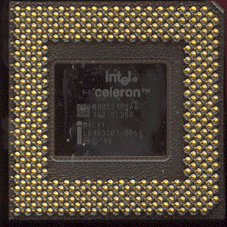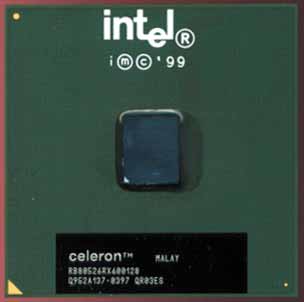PPGA is old news
 As
we discussed at the beginning of this article, Intel’s Celeron 300A was the
first Celeron to feature an on-die L2 cache. Not only did the on-die L2 cache
run at clock speed and offer very low latency L2 access when compared to the
Pentium II’s off-die L2 cache (it’s obviously easier for the CPU to access something
that is contained within its die than something that is outside of its die),
but by moving the L2 cache onto the processor’s die, Intel also managed to eliminate
the need for the Celeron’s SEPP (Single Edge Processor Package) card.
As
we discussed at the beginning of this article, Intel’s Celeron 300A was the
first Celeron to feature an on-die L2 cache. Not only did the on-die L2 cache
run at clock speed and offer very low latency L2 access when compared to the
Pentium II’s off-die L2 cache (it’s obviously easier for the CPU to access something
that is contained within its die than something that is outside of its die),
but by moving the L2 cache onto the processor’s die, Intel also managed to eliminate
the need for the Celeron’s SEPP (Single Edge Processor Package) card.
Intel eventually phased out the SEPP Celeron in favor of the PPGA (Plastic Pin Grid Array) Socket-370 version that, as the name implies and as we all are familiar with today, interfaces with a socket rather than a slot which helps to cut costs since Intel isn’t paying for the production of a PCB to mount the CPU on in addition to the CPU.

Around the time of the release of the Celeron 366, the first PPGA Socket-370 Celerons were made available, and by the time the 433MHz parts were released, finding an SEPP processor was virtually impossible.
The only problem with the PPGA packaging was that the heat generated by the CPU’s core never actually made contact with the heatsink on the outside of the package. Instead, the heat was dissipated through the package and then out to the heatsink. While this was fine for the older 266 – 533MHz parts, as the Celeron began to approach the 600MHz mark, removing the heat from the processor’s core in an efficient manner became increasingly difficult.
In order to get around this problem and pave the way for higher clock speed parts in the future, Intel began using a technology known as Flip Chip Pin Grid Array (FC-PGA) to package their processors starting with the Pentium III. This method of packaging, as the name implies, actually flips the die so that it is essentially resting against the base of the heatsink (under a protective layer, of course), but by doing this, it is easier to dissipate the amount of heat generated by these chips.
FC-PGA Pentium III

FC-PGA Celeron

The FC-PGA core, as well as the fact that the Coppermine128 is manufactured on Intel’s 0.18-micron Coppermine process, makes the 18W dissipated by the new Celeron running at 600MHz a very appetizing figure. To put it into perspective, at 18W, the Celeron 600 dissipates less heat than the newer Pentium III 550E (18.2W) and just barely more than the old Celeron 300A (17.8W).










0 Comments
View All Comments